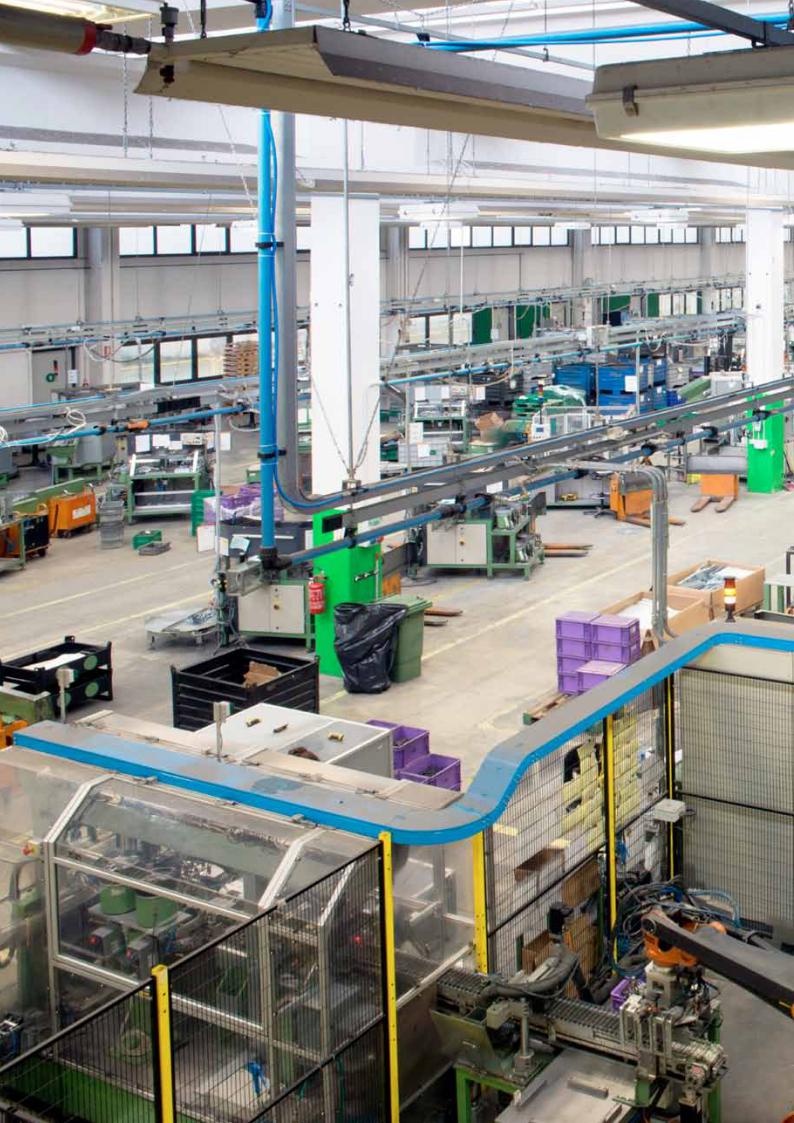
Report - How Robots Change the World_watermark
.pdf
vk.com/id446425943
HOW ROBOTS CHANGE
THE WORLD
WHAT AUTOMATION REALLY MEANS FOR JOBS AND PRODUCTIVITY
JUNE 2019

vk.com/id446425943

vk.com/id446425943
How Robots Change the World
TABLE OF CONTENTS
Foreword |
3 |
Executive summary |
4 |
Introduction |
11 |
What drives the robot rise? |
13 |
Three reasons for the robot surge |
16 |
The impact of robots on manufacturing jobs |
19 |
Global impacts |
19 |
Regional impacts |
22 |
The Robot Vulnerability Index |
25 |
United States |
27 |
Germany |
28 |
United Kingdom |
29 |
France |
30 |
Japan |
31 |
South Korea |
32 |
Australia |
33 |
The robotics dividend |
35 |
Reshaping the labour market |
37 |
Robots are coming to the service sector |
40 |
The future impact of robots on five key service industries |
43 |
Where service robots go from here |
49 |
How to respond to the rise of robots |
51 |
A framework for action |
53 |
Appendix: econometric analysis |
56 |
1

vk.com/id446425943
Fieldwork Robotics trialling a robot raspberry harvesting
system on a British farm, 2019.

vk.com/id446425943
How Robots Change the World
FOREWORD:
The Shape of Things to Come
|
The robotics revolution is |
|
rapidly accelerating, as fast- |
|
paced technological advances |
|
in automation, engineering, |
|
energy storage, artificial |
|
intelligence, and machine |
|
learning converge. The result |
|
will transform the capabilities |
|
of robots and their ability to |
|
take over tasks once carried |
|
out by humans. |
Adrian Cooper |
The number of robots in |
use worldwide multiplied |
|
CEO and Chief Economist |
three-fold over the past two |
Oxford Economics |
decades, to 2.25 million. Trends |
|
suggest the global stock of |
|
robots will multiply even faster |
|
in the next 20 years, reaching |
|
as many as 20 million by 2030, |
|
with 14 million in China alone. |
|
The implications are immense, |
|
and the emerging challenges |
|
for governments and policy- |
|
makers are equally daunting in |
|
their scale. |
|
The rise of the robots will |
|
boost productivity and |
|
economic growth. It will lead, |
|
too, to the creation of new |
|
jobs in yet-to-exist industries, |
|
in a process of ‘creative |
|
destruction.’ But existing |
|
business models across many |
|
sectors will be seriously |
|
disrupted. And tens of millions |
|
of existing jobs will be lost, |
|
with human workers displaced |
|
by robots at an increasing rate |
|
as robots become steadily |
|
more sophisticated. |
|
For both people and |
|
businesses, the effects of these |
|
job losses will vary greatly |
|
across countries and regions, |
|
with a disproportionate toll |
|
on lower-skilled workers and |
on poorer local economies. In many places, the impact will aggravate social and economic stresses from unemployment and income inequality in times when increasing political polarisation is already a worrying trend.
At Oxford Economics our mission is to help our clients better understand an evermore complex and fastchanging world economy, in all its dimensions—and how to successfully operate in it. Our clients look to us to explain the forces shaping their economic environment, help them anticipate the future, and plan for its uncertainties.
That is why we brought together a team of our economists, econometricians, modellers and technology experts from across our worldwide network of over 250 analysts to conduct an extensive research study
to analyse the robotics phenomenon. We are pleased to share our findings not only with our clients but with all who want to understand the implications of one of the most profound shifts
the world economy will experience this century.
3

vk.com/id446425943
How Robots Change the World
EXECUTIVE SUMMARY
20m
Number of manufacturing jobs that could be displaced by industrial robots by 2030—8.5% of the global manufacturing workforce.
Over the past decade, a robotics revolution has captured the world’s imagination. As their capabilities expand, so does the rate at which industries purchase and install these increasingly intelligent machines. Since 2010, the global stock of industrial robots has more than doubled—and innovations in engineering and machine learning portend an accelerated adoption of robots in service sector occupations over the next five years.
This report sheds new light on both the current impact of robots on manufacturing jobs around the world and the potential
for robots to transform the much larger (but as-yet far less automated) global services sector. To evaluate the implications of this ongoing robot revolution, we have brought together the combined expertise of Oxford Economics’ economists, econometricians, modellers, and subject-matter experts.
The rise of robots has already had a profound effect on industrial employment around the world: today, approximately one of every three new manufacturing robots is being installed in China, the world’s great workshop. Our econometric modelling finds that on average each newly installed robot displaces 1.6 manufacturing workers.1 By 2030, we estimate that as many as 20 million additional manufacturing jobs worldwide could be displaced due to robotization.2
Lower-income regions are more at risk
This great displacement will not be evenly distributed around the world, or within countries. Our research shows that the negative effects of robotization are disproportionately felt in the lower-income regions of the globe’s major economies—on average, a new robot displaces nearly twice as many jobs in lower-income regions compared with higher-income regions of the same country.3 At a time of worldwide concern about growing levels of economic inequality and political polarisation, this finding has important social and political implications.
Given the stakes, policy-makers need an early warning system to help them mitigate the risks of automation on employment. As part of this study, we have developed a Robot Vulnerability Index that ranks every region of seven developed economies in terms of how susceptible their respective workforces are to the installation of industrial robots (see page 25).
4 |
1 This finding is based on an analysis of a large, regional panel-dataset of robot stock, and other labour market indicators, over a 11 year timeframe, for 24 |
|
EU countries (minus Croatia, Cyprus, Luxembourg and Malta), along with Norway, the United States, Japan, and South Korea. |
2Countries included in this estimate account for more than 90% of industrial robot installations: EU 28, US, Japan, South Korea, Australia, China, Taiwan, Thailand, Mexico, India, Canada, Singapore, Brazil, Turkey, Malaysia. We assume the rate of robot installations in manufacturing up to 2030 follows the latest projections by the International Federation of Robotics, and we also account for long-term depreciation of existing robot stock.
3 Throughout this report, higherand lower-income regions are defined as those with average household income levels above and below the national
average, respectively.

vk.com/id446425943
How Robots Change the World
In many cases, our Index highlights that the most vulnerable regions are somewhat removed from the wealthier districts of their home countries—such as Cumbria in the UK, FrancheComté in France, and the high desert of Eastern Oregon in the US. These rural regions often include towns or cities with strong manufacturing heritages that play a surprisingly large part in the regional economy. In contrast, regions that surround knowledgeintensive cities, such as Toulouse and Grenoble in France, or Munich and Stuttgart in Germany, typically show much lower levels of vulnerability to the rise of the robots. This is also true of capital cities such as London, Paris, Seoul, and Tokyo.
Fig.1: Job losses from robots hit lower-income regions harder4
Change in number of jobs due to one additional robot
Our research shows the negative effects of robotization are
disproportionately felt in the lower-income regions of major economies.
-1.6
-2.2
-1.3
Average e ect
Lowerincome regions
Higherincome regions
-2.5 |
-2.0 |
-1.5 |
-1.0 |
-0.5 |
0.0 |
|
Long-term impact |
|
Short-term impact |
|
|
Source: Oxford Economics
4 Our modelling differentiates between a “short-term” effect, within the year of a robot installation, and a longer-term effect that builds over 10 to 15 years. |
5 |

vk.com/id446425943
How Robots Change the World
As the pace of robotics adoption quickens, policy-makers will be faced with a dilemma: while robots enable growth, they exacerbate income inequality.
The $5 trillion robotics dividend
While regional impacts vary, fears about permanent global job destruction generated by robots appear somewhat exaggerated. Our study shows that the current wave of robotization tends
to boost productivity and economic growth, generating new employment opportunities at a rate comparable to the pace of job destruction. We estimate that a 1% increase in the stock of robots per worker in the manufacturing sector leads to 0.1% boost to output per worker across the wider workforce.
These increases are large enough to drive meaningful growth. Using Oxford Economics’ Global Economic Model (GEM), we calculated how changes in the rate of installation of industrial robots could affect the global economy. Overall, we found that a faster adoption of robots has a positive impact on both shortand medium-term growth. For example, boosting robot
installations to 30% above the baseline forecast by 2030 would lead to an estimated 5.3% boost in global GDP that year. This equates to adding an extra $4.9 trillion per year to the global economy by 2030 (in today’s prices)—equivalent to an economy greater than the projected size of Germany’s.
The future of service robots
Robots are steadily gaining traction in specific segments of the service economy, from baggage handling in airports to loading inventory in warehouses. In this report, we assess the likely impact (and timeframe) of service robot roll-outs in five key sectors: healthcare, retail, hospitality, transport, and
construction and farming. For the purposes of this study we are considering robots only as physical machines, and not including the already-popular service-industry software like robotic process automation (RPA) that can speak, hear, read, conduct transactions, automate processes, and so on.
One key consideration for anticipating the pace of robot deployment in service industries is the environment in which these robots may be asked to operate—in particular, the extent to which service jobs include repetitive functions. Jobs like warehouse work are in imminent danger, while other jobs in less structured environments will likely be carried out by humans for decades to come.
6

vk.com/id446425943
How Robots Change the World
It will be difficult for machines to replace humans in service |
|
sector occupations that demand compassion, creativity, and |
It will be difficult for |
social intelligence. Physical therapists, dog trainers, and social |
|
workers are likely to remain secure in their jobs, for instance, |
machines to replace |
even if truckers and warehouse workers see the future of their |
humans in service sector |
jobs jeopardised. |
occupations that demand |
|
|
Policy implications |
compassion, creativity, |
As the pace of robotics adoption quickens, policy-makers will |
and social intelligence. |
be faced with a dilemma: while robots enable growth, they |
|
exacerbate income inequality. Automation will continue to |
|
drive regional polarisation in many of the world’s advanced |
|
economies, unevenly distributing the benefits and costs |
|
across the population. This trend will intensify as the impact of |
|
automation on jobs spreads from manufacturing to the services |
|
sector, making questions about how to deal with displaced |
|
workers increasingly critical. |
|
The challenges will be daunting. Our analysis of the job |
|
moves of more than 35,000 US individuals over the course of |
|
their careers shows that more than half the workers who left |
|
production jobs in the past two decades were absorbed into |
|
just three occupational categories: transport, construction and |
|
maintenance, and office and administration work. Ominously, |
|
our analysis found that these three occupational areas are |
|
among the most vulnerable to automation over the next decade. |
|
These findings, however, should not lead policy-makers and |
|
other stakeholders to seek to frustrate the adoption of robot |
|
technology. Instead the challenge should be to distribute the |
|
robotics dividend more evenly by helping vulnerable workers |
|
prepare for and adapt to the upheaval it will bring. Policy- |
|
makers, business leaders, technology companies, educators, and |
|
workers all have a role to play. We conclude the report with a |
|
framework for action for each of these groups to navigate the |
|
challenges and opportunities that robotization will bring. |
|
Robots are on the rise as never before. Preparing for and |
|
responding to the social impacts of automation will be a |
|
defining challenge of the next decade. |
|
7

vk.com/id446425943
